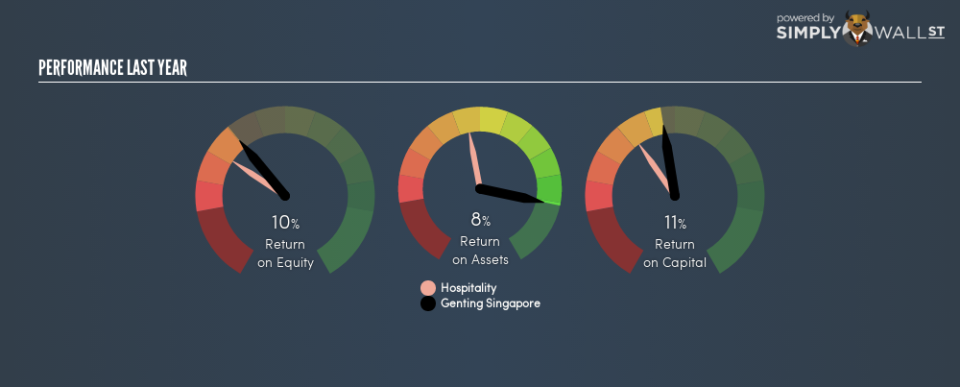Why We Like Genting Singapore Limited’s (SGX:G13) 11% Return On Capital Employed

Want to participate in a short research study? Help shape the future of investing tools and you could win a $250 gift card!
Today we’ll look at Genting Singapore Limited (SGX:G13) and reflect on its potential as an investment. Specifically, we’re going to calculate its Return On Capital Employed (ROCE), in the hopes of getting some insight into the business.
First up, we’ll look at what ROCE is and how we calculate it. Second, we’ll look at its ROCE compared to similar companies. Then we’ll determine how its current liabilities are affecting its ROCE.
Understanding Return On Capital Employed (ROCE)
ROCE is a measure of a company’s yearly pre-tax profit (its return), relative to the capital employed in the business. Generally speaking a higher ROCE is better. Ultimately, it is a useful but imperfect metric. Renowned investment researcher Michael Mauboussin has suggested that a high ROCE can indicate that ‘one dollar invested in the company generates value of more than one dollar’.
How Do You Calculate Return On Capital Employed?
The formula for calculating the return on capital employed is:
Return on Capital Employed = Earnings Before Interest and Tax (EBIT) ÷ (Total Assets – Current Liabilities)
Or for Genting Singapore:
0.11 = S$892m ÷ (S$9.5b – S$814m) (Based on the trailing twelve months to September 2018.)
Therefore, Genting Singapore has an ROCE of 11%.
See our latest analysis for Genting Singapore
Is Genting Singapore’s ROCE Good?
ROCE can be useful when making comparisons, such as between similar companies. In our analysis, Genting Singapore’s ROCE is meaningfully higher than the 3.7% average in the Hospitality industry. We would consider this a positive, as it suggests it is using capital more effectively than other similar companies. Independently of how Genting Singapore compares to its industry, its ROCE in absolute terms appears decent, and the company may be worthy of closer investigation.
In our analysis, Genting Singapore’s ROCE appears to be 11%, compared to 3 years ago, when its ROCE was 7.8%. This makes us wonder if the company is improving.
When considering this metric, keep in mind that it is backwards looking, and not necessarily predictive. Companies in cyclical industries can be difficult to understand using ROCE, as returns typically look high during boom times, and low during busts. ROCE is only a point-in-time measure. Since the future is so important for investors, you should check out our free report on analyst forecasts for Genting Singapore.
Genting Singapore’s Current Liabilities And Their Impact On Its ROCE
Short term (or current) liabilities, are things like supplier invoices, overdrafts, or tax bills that need to be paid within 12 months. Due to the way ROCE is calculated, a high level of current liabilities makes a company look as though it has less capital employed, and thus can (sometimes unfairly) boost the ROCE. To counteract this, we check if a company has high current liabilities, relative to its total assets.
Genting Singapore has total assets of S$9.5b and current liabilities of S$814m. Therefore its current liabilities are equivalent to approximately 8.5% of its total assets. Low current liabilities have only a minimal impact on Genting Singapore’s ROCE, making its decent returns more credible.
What We Can Learn From Genting Singapore’s ROCE
This is good to see, and while better prospects may exist, Genting Singapore seems worth researching further. You might be able to find a better buy than Genting Singapore. If you want a selection of possible winners, check out this free list of interesting companies that trade on a P/E below 20 (but have proven they can grow earnings).
If you like to buy stocks alongside management, then you might just love this free list of companies. (Hint: insiders have been buying them).
To help readers see past the short term volatility of the financial market, we aim to bring you a long-term focused research analysis purely driven by fundamental data. Note that our analysis does not factor in the latest price-sensitive company announcements.
The author is an independent contributor and at the time of publication had no position in the stocks mentioned. For errors that warrant correction please contact the editor at editorial-team@simplywallst.com.

 Yahoo Finance
Yahoo Finance 
